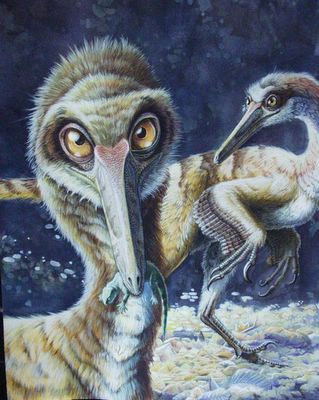
Buitreraptor gonzalezorum munching on prey. © 2005 Field MuseumThe earliest dromaeosaurid theropod from South America. 2005. Peter J. Makovicky, Sebastián Apesteguía and Federico L. Agnolín. Nature 437:1007-1011.
Abstract: The evolutionary history of Maniraptora, the clade of carnivorous dinosaurs that includes birds and the sickle-clawed Dromaeosauridae, has hitherto been largely restricted to Late Jurassic and Cretaceous deposits on northern continents. The stunning Early Cretaceous diversity of maniraptorans from Liaoning, China, coupled with a longevity implied by derived Late Jurassic forms such as Archaeopteryx, pushes the origins of maniraptoran lineages back to Pangaean times and engenders the possibility that such lineages existed in Gondwana. A few intriguing, but incomplete, maniraptoran specimens have been reported from South America, Africa and Madagascar. Their affinities remain contested, however, and they have been interpreted as biogeographic anomalies relative to other faunal components of these land-masses. Here we describe a near-complete, small dromaeosaurid that is both the most complete and the earliest member of the Maniraptora from South America, and which provides new evidence for a unique Gondwanan lineage of Dromaeosauridae with an origin predating the separation between northern and southern landmasses.

Reconstructed skeleton of Buitreraptor gonzalezorum. Long hindlimbs indicate it was a fast runner. Elongated arms and massive shoulder girdle suggest powerful prey-grasping abilities. © 2005 Field Museum, Photo by John Weinstein.From Livescience.com come this article by Robert Britt:
The discovery of a bird-like dinosaur in South America has paleontologists rethinking when, where and how one group of raptors evolved. The rooster-sized dinosaur is called Buitreraptor (bwee-tree-rap-tor) gonzalezorum. It has a long head and long tail and wing-like forelimbs. Its serrated teeth, like steak knives, suggest it was a carnivore.
Buitreraptor is related to Velociraptor, the presumed cunning killer made famous by Hollywood. Both belong to a class of birdlike dinosaurs that ran swiftly on two legs and are called dromaeosaurs. The new find suggests such raptors go back much further in time that previously thought.
Until recently, dromaeosaurs had been found only in Asia and North America and only in the Cretaceous period, which ran from 145 million to 65 million years ago. Evidence that they existed in the Southern Hemisphere has been mounting.
"Buitreraptor is one of those special fossils that tells a bigger story about the Earth's history and the timing of evolutionary events," said Peter Makovicky, Curator of Dinosaurs at The Field Museum. "It not only provides definitive evidence for a more global distribution and a longer history for dromaeosaurs than was previously known, but also suggests that dromaeosaurs on northern and southern continents took different evolutionary routes after the landmasses they occupied drifted apart."

The skeleton of Buitreraptor gonzalezorum in the field. A string of vertebrae and the right shoulder (lower left) and femur are showing. The matchstick shows scale. Photo by Peter Makovicky, Courtesy of the Field Museum.